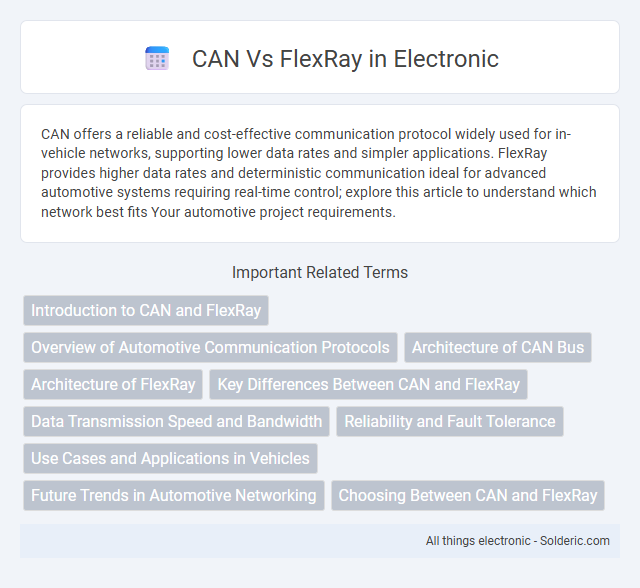CAN offers a reliable and cost-effective communication protocol widely used for in-vehicle networks, supporting lower data rates and simpler applications. FlexRay provides higher data rates and deterministic communication ideal for advanced automotive systems requiring real-time control; explore this article to understand which network best fits Your automotive project requirements.
Comparison Table
| Feature | CAN (Controller Area Network) | FlexRay |
|---|---|---|
| Data Rate | Up to 1 Mbps | Up to 10 Mbps |
| Protocol Type | Message-based, event-triggered | Time-triggered and event-triggered hybrid |
| Topology | Bus | Bus or Star |
| Fault Tolerance | Basic error detection | High fault tolerance with dual channels |
| Latency | Variable, higher latency | Deterministic, low latency |
| Application | Simple control systems, automotive body electronics | Advanced automotive systems, safety-critical applications |
| Standard | ISO 11898 | ISO 17458 |
| Complexity & Cost | Lower complexity, cost-effective | Higher complexity, more expensive |
Introduction to CAN and FlexRay
CAN (Controller Area Network) is a robust vehicle bus standard designed for efficient real-time communication between microcontrollers and devices without a host computer. FlexRay, on the other hand, is a high-speed communication protocol developed to meet the increasing demand for faster data transfer and fault tolerance in advanced automotive applications. Understanding the distinctions in bandwidth, latency, and reliability between CAN and FlexRay helps you select the optimal network for your vehicle's electronic control systems.
Overview of Automotive Communication Protocols
CAN (Controller Area Network) and FlexRay are automotive communication protocols designed for in-vehicle networks, with CAN widely used for its robustness and real-time capabilities in engine control and body electronics. FlexRay offers higher data rates up to 10 Mbps and deterministic data transmission, making it ideal for advanced safety systems and autonomous driving applications. Understanding the differences in bandwidth, latency, and fault tolerance between CAN and FlexRay can help optimize your vehicle's communication architecture for performance and reliability.
Architecture of CAN Bus
CAN Bus architecture features a multi-master, message-oriented protocol that enables efficient communication between microcontrollers and devices without a host computer. It employs a differential two-wire system (CAN_H and CAN_L) for robust noise immunity and supports prioritized message arbitration to prevent data collisions. Your automotive or industrial network benefits from CAN's simplicity, fault tolerance, and real-time data transfer capabilities in distributed control systems.
Architecture of FlexRay
FlexRay architecture features a dual-channel communication system offering fault tolerance and increased data bandwidth compared to the single-channel CAN bus. It employs a time-triggered protocol with static and dynamic segments, allowing deterministic message scheduling for real-time automotive applications. The FlexRay network supports star and bus topologies, enhancing scalability and robustness in distributed embedded systems.
Key Differences Between CAN and FlexRay
CAN (Controller Area Network) offers a lower data rate of up to 1 Mbps and is widely used for real-time, cost-effective communication in automotive and industrial systems, while FlexRay supports higher data rates up to 10 Mbps, enabling deterministic and fault-tolerant communication for advanced automotive applications like autonomous driving. FlexRay employs a time-triggered protocol ensuring precise synchronization and time-slot-based message transmission, contrasting with CAN's event-driven arbitration that can introduce variable latency. The robust fault tolerance and dual-channel architecture of FlexRay provide enhanced reliability over CAN's single-channel bus topology, making it suitable for safety-critical systems requiring high bandwidth and redundancy.
Data Transmission Speed and Bandwidth
FlexRay offers significantly higher data transmission speeds compared to CAN, with FlexRay supporting up to 10 Mbps versus CAN's standard maximum of 1 Mbps, enabling faster communication in automotive networks. FlexRay's bandwidth is also greater, utilizing a dual-channel architecture that provides up to 20 Mbps total throughput, enhancing fault tolerance and enabling simultaneous data transmission. These attributes make FlexRay ideal for time-critical applications requiring deterministic data delivery, while CAN suits simpler, lower-speed control systems.
Reliability and Fault Tolerance
FlexRay offers superior reliability and fault tolerance compared to CAN due to its dual-channel architecture enabling simultaneous transmission and automatic error detection. CAN supports robust error handling with retransmission, but its single-channel design limits fault isolation and recovery capabilities. Your system benefits from FlexRay's deterministic data delivery and enhanced resilience in safety-critical automotive applications.
Use Cases and Applications in Vehicles
CAN (Controller Area Network) is widely used for intra-vehicle communication in engine management, body control, and infotainment systems due to its simplicity and real-time capabilities. FlexRay, with higher data rates and deterministic timing, is favored in advanced driver-assistance systems (ADAS), chassis control, and safety-critical applications requiring fault tolerance and synchronization. Both networks complement each other in modern vehicles, optimizing communication efficiency across different electronic control units (ECUs).
Future Trends in Automotive Networking
CAN (Controller Area Network) remains vital for basic sensor and actuator communication in vehicles due to its simplicity and reliability, but its limited bandwidth restricts high-speed data exchange. FlexRay offers enhanced bandwidth, deterministic timing, and fault tolerance, supporting advanced applications like autonomous driving and real-time safety systems. Emerging trends emphasize integrating FlexRay with high-speed Ethernet and Time-Sensitive Networking (TSN) to meet the demands of increasingly connected and automated vehicles.
Choosing Between CAN and FlexRay
Choosing between CAN and FlexRay depends on the complexity and speed requirements of the automotive network. CAN offers robust, cost-effective communication suited for simpler systems with data rates up to 1 Mbps, while FlexRay supports higher speeds up to 10 Mbps and deterministic timing essential for advanced driver assistance systems and autonomous driving. Evaluating application-specific demands, such as real-time performance and fault tolerance, is critical in selecting the appropriate protocol for in-vehicle communication.
CAN vs FlexRay Infographic

 solderic.com
solderic.com